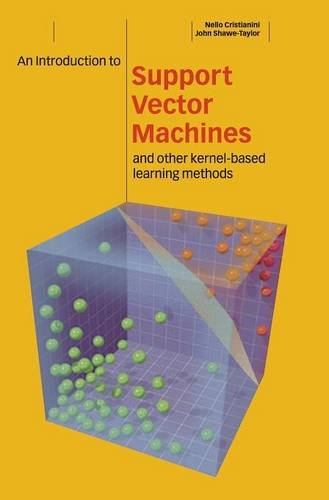An Introduction to Support Vector Machines and Other Kernel-based Learning Methods pdf
Par bostic lita le dimanche, mai 29 2016, 06:27 - Lien permanent
An Introduction to Support Vector Machines and Other Kernel-based Learning Methods. John Shawe-Taylor, Nello Cristianini

An.Introduction.to.Support.Vector.Machines.and.Other.Kernel.based.Learning.Methods.pdf
ISBN: 0521780195,9780521780193 | 189 pages | 5 Mb

An Introduction to Support Vector Machines and Other Kernel-based Learning Methods John Shawe-Taylor, Nello Cristianini
Publisher: Cambridge University Press
In contrast, in rank-based methods (Figure 1b), such as [2,3], genes are first ranked by some suitable measure, for example, differential expression across two different conditions, and possible enrichment is found near the extremes of the list. Kernel methods in general have gained increased attention in recent years, partly due to the grown of popularity of the Support Vector Machines. Shawe, An Introduction to Support Vector Machines and other Kernel-based Learning Methods, Cambridge University Press, New York, 2000. In addition, to obtain good predictive power, various machine-learning algorithms such as support vector machines (SVMs), neural networks, naïve Bayes classifiers, and ensemble classifiers have been used to build classification and prediction models. Of these [35] suggested that no single-classifier method can always outperform other methods and that ensemble classifier methods outperform other classifier methods because they use various types of complementary information. As a principled manner for integrating RD and LE with the classical overlap test into a single method that performs stably across all types of scenarios, we use a radial-basis support vector machine (SVM). This is the first comprehensive introduction to Support Vector Machines (SVMs), a new generation learning system based on recent advances in statistical learning theory. Support Vector However, modifications had been based on GPL code by Sylvain Roy. Support Vector Machine (SVM) is a supervised learning algorithm developed by Vladimir Vapnik and his co-workers at AT&T Bell Labs in the mid 90's. In this review, we describe the basic concepts and algorithms behind machine learning-based genetic feature selection approaches, their potential benefits and limitations in genome-wide setting, and how physical or genetic interaction networks Introduction. Most disease phenotypes are genetically complex, with contributions from combinations of genetic variation in different loci. Bounds the influence of any single point on the decision boundary, for derivation, see Proposition 6.12 in Cristianini/Shaw-Taylor's "An Introduction to Support Vector Machines and Other Kernel-based Learning Methods". In simple words, given a set of training examples, each marked as belonging to one of two categories, a SVM training algorithm builds a model that predicts whether a new example falls into one category or the other. Shawe-Taylor “An Introduction to Support Vector Machines and Other Kernel-based.